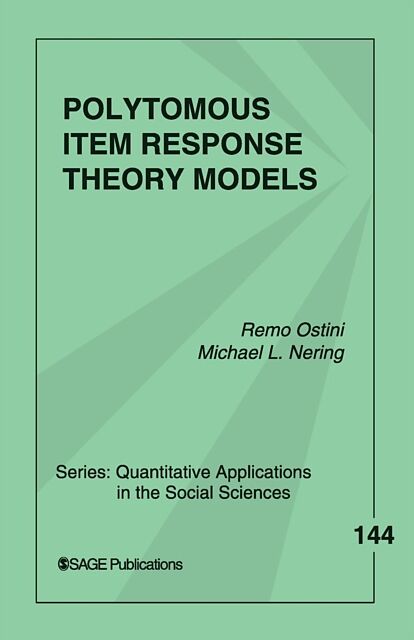Polytomous Item Response Theory Models
Einband:
Kartonierter Einband
EAN:
9780761930686
Autor:
Remo Ostini, Michael L. Nering
Herausgeber:
Sage Publications, Inc
Erscheinungsdatum:
05.08.2005
undefined
Autorentext
After specializing in psychometric methods and bioethics at the University of Minnesota, Remo taught 3020 and 4050 in the School of Psychology at UQ for a number of years. A stint in the School of Pharmacy at UQ, doing systematic reviews of medicine prescribing and some pharmacoepidemiology, followed. Now Remo has gone back to his roots, measuring health behaviors and community well being in the Healthy Communities Research Center at UQ. Remos research focuses on health literacy, including the effect of health literacy on health behaviors as well as predictors and components of health literacy. Of particular interest are the issues of health literacy motivation and responsibility. Remo maintains an honorary appointment in the School of Psychology and continues to supervise students in the school.Dr. Nering joined Measured Progress as a psychometrician in 1999. In this capacity as assistant vice president of psychometrics and research, he is responsible for all psychometric services provided by Measured Progress. He also oversees all research activities and both the summer internship program and the visiting scholar program. Prior to joining Measured Progress, Dr. Nering was a psychometrician for ACT, Inc., where he was extensively involved in research on the computerized adaptive test version of the ACT assessment. He also provided psychometric support for the Council of Chief State School Officers (CCSSO) science test and conducted research for the development division in the Support, Technological Applications, and Research department. In addition to his experience in psychometrics, Dr. Nering has taught at the college level, served as an item writer for a variety of assessment instruments, tested and developed software packages, and published and presented numerous papers on measurement and testing. Dr. Nerings research interests include person fit, item response theory, computer-based testing, and equating. He has presented and published numerous articles on a wide range of psychometric topics, and he is actively involved in the research community in various capacities. Dr. Nering is a member of the National Council of Measurement in Education, American Educational Research Association, American Psychological Association, and the Psychometric Society. For the AERA 2005 conference he was a program chair for Division D Measurement and Research Methodology. He has also served as treasurer of the Psychometric Society. In addition, Dr. Nering has served as reviewer for several peer journals, including the Journal of Educational Measurement, Applied Psychological Measurement, Psychometrika, and the Journal of Experimental Education. Dr. Nering has a Ph.D. in psychology with a specialization in psychometric methods from the University of Minnesota and a Bachelors degree in psychology from Kent State University, Kent, OH.
Klappentext
Polytomous Item Response Theory Models provides a unified, comprehensive introduction to the range of polytomous models available within item response theory (IRT). It begins by outlining the primary structural distinction between the two
Inhalt
Series Editor s Introduction
Acknowledgments
1. Introduction
Measurement Theory
Item Response Theory
Applying the IRT Model
Reasons for Using Polytomous IRT Models
Polytomous IRT Models
Two Types of Probabilities
Two Types of Polytomous Models
Category Boundaries
Item Category Response Functions
2. Nominal Response Model
The Mathematical Model
Information
Relationship to Other IRT Models
Variations
A Practical Example
3. Polytomous Rasch Models
Partial Credit Model
Category Steps
The Mathematical Model
Information
Relationship to Other IRT Models
Variations
PCM Summary
Rating Scale Model
The Mathematical Model
Model Parameters
Sufficient Statistics and Other Considerations
Information
Expected Values and Response Functions
Response Functions and Information
Relationship to Other IRT Models
PCM Scoring Function Formulation and the NRM
Variations
Generalized Partial Credit Model
Discrimination and Polytomous Rasch Models
Summary of Polytomous Rasch Models
Three Practical Examples
4. Samejima Models
Framework
From Response Process to Specific Model
The Homogeneous Case: Graded Response Models
The Mathematical Model
Information
Information for Polytomous Models
Relationship to Other IRT Models
From Homogeneous Class to Heterogeneous Class and Back
A Common Misconception
Variations
Summary of Samejima Models
Potential Weaknesses of the Cumulative Boundary Approach
Possible Strengths of the Cumulative Boundary Approach
A Practical Example
5. Model Selection
General Criteria
Mathematical Approaches
Fit Statistic Problems
An Example
Differences in Modeled Outcome
Conclusion
Acronyms and Glossary
Notes
References
Index
About the Authors

Leider konnten wir für diesen Artikel keine Preise ermitteln ...
billigbuch.ch sucht jetzt für Sie die besten Angebote ...
Die aktuellen Verkaufspreise von 6 Onlineshops werden in Realtime abgefragt.
Sie können das gewünschte Produkt anschliessend direkt beim Anbieter Ihrer Wahl bestellen.
Loading...
Die aktuellen Verkaufspreise von 6 Onlineshops werden in Realtime abgefragt.
Sie können das gewünschte Produkt anschliessend direkt beim Anbieter Ihrer Wahl bestellen.
| # | Onlineshop | Preis CHF | Versand CHF | Total CHF | ||
|---|---|---|---|---|---|---|
| 1 | Seller | 0.00 | 0.00 | 0.00 |
